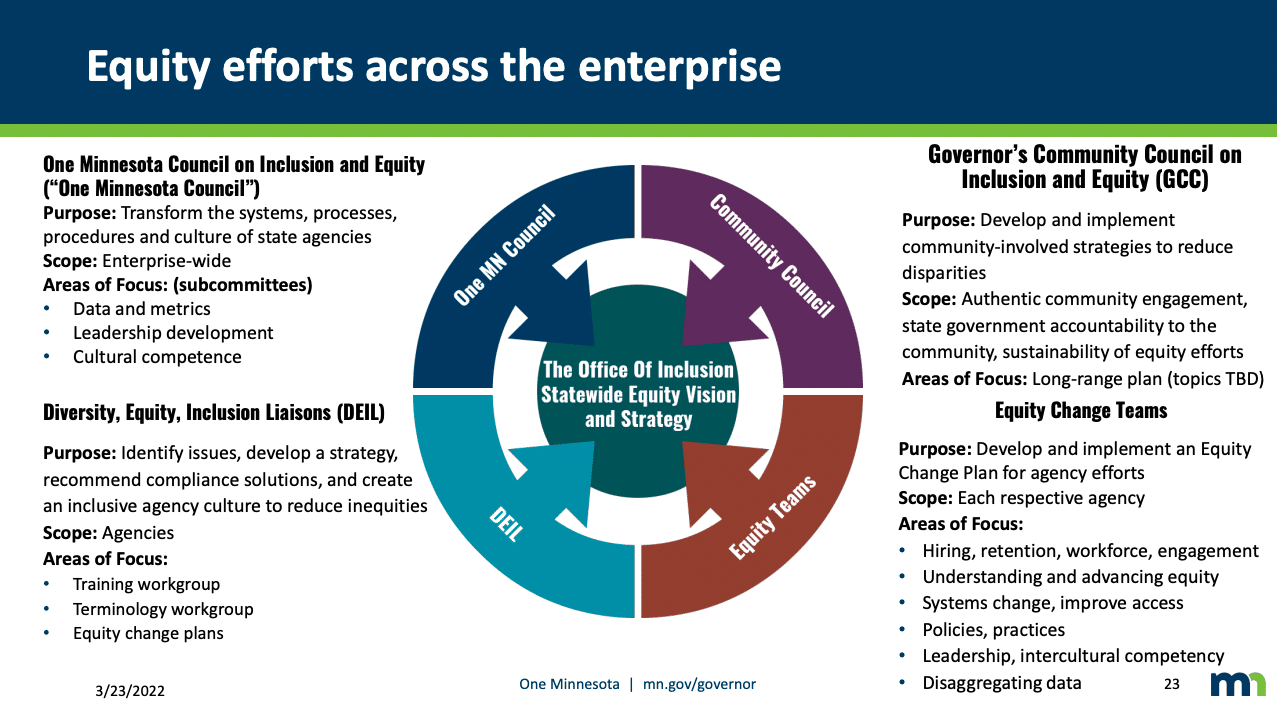by Anthony Gockowski
Gov. Tim Walz’s very first executive order, issued on his second day in office, established the “One Minnesota Council on Inclusion and Equity.”
This is not to be confused with the “Governor’s Community Council on Inclusion and Equity,” established at a later date to advise the first council.
The community council is composed of various nonprofit, business, and university leaders, such as the vice president of Education Minnesota and an “anti-racism trainer” from St. Cloud State University. The “One Minnesota Council” is composed of some of Walz’s agency heads and two staff members.
Public documents from the “community council’s” meetings, beginning in September 2021, reveal the extent of the Walz administration’s attempt to, in its own words, “embed equity and inclusion in state systems and structures.”
A presentation from its December meeting identifies “anti-racism” as a key component of this effort, so much so that Lt. Gov. Peggy Flanagan helped develop an “anti-racism tool,” according to the meeting minutes.
This tool is necessary because “the U.S. economy was built on the exploitation and occupational segregation of People of Color and American Indian People.”
“Many people, governmental policies, and institutional practices have had a role in creating racial disparities,” the presentation explains.
But this tool “does not guarantee anti-racist outcomes.”
“Our norms are grounded in Whiteness. Intentionality is needed to center anti-racist practices,” the December presentation adds.
These equity efforts go beyond the two governor’s councils; there are also “diversity, equity and inclusion liaisons” who “recruit and lead an Equity Team within each agency.”
“The Equity Team will develop and implement a plan that will produce and embed equity outcomes within the agency. The DEI Liaison will recruit members for the team and serve as the liaison between the team, the Office of Inclusion, and the One Minnesota Council for Inclusion and Equity,” an October presentation from a community council meeting states.

One of the first projects of the community council was analyzing the results of an “equity inventory” of all state agencies, which was conducted by the “DEI liaisons.” This inventory asked departments to provide examples of policies that “advance racial equity,” identify their top legislative priorities related to “racial equity,” and explain the “infrastructure” they have in place “to support racial equity initiatives.”
Some agencies said they have equity “training requirements” for employees or are adding “DEI language to position descriptions.” The Minnesota Department of Human Rights said it no longer requires “law degrees for its investigators” because this would “automatically exclude qualified people of color.”
The Department of Employment and Economic Development said it hosts a monthly “diversity spotlight” for staff “to learn about diverse lived experience[s], followed by discussions to reflect on what they learn and how they will incorporate what they have learned into their work.”
A November presentation from the community council asserts the state should play a key role in “changing narratives” about racial equity.
“Expand the definition of what government can and must do, and the extent to which it has a responsibility to solve the consequences of structural racism,” says a bullet point in the presentation.
“Normalize conversations about race by explicitly including equity data and terms that include social justice, racism, oppression, and power,” adds another.
The community council, along with the “diversity liaisons,” are now meeting in small groups to discuss the different “potential levers for change” where the government can “address systemic racism.” These “levers” include human resources policies, training development, “policy reviews,” grant-making policies, and more.
The community council’s purported purpose is to “lead the charge and empower others to advance equity and improve outcomes.” Chris Taylor, the governor’s “chief inclusion officer,” expanded on the purpose of the council during a February meeting, according to the meeting minutes.
“The chief inclusion officer talked about how the Equity Framework takes a systems approach, and by focusing on the five areas of the Equity Framework, the GCC can help bring about a long-term sustainable shift, which will make centering equity the ‘new normal’ within state government,” the minutes explain.
Alpha News reached out to Minnesota’s “Office of Inclusion,” which oversees these efforts, for comment but did not receive a response.
– – –
Anthony Gockowski is Editor-in-Chief of Alpha News. He previously worked as an editor for The Minnesota Sun and Campus Reform, and reported for The Daily Caller.
Photo “Tim Walz” by Governor Tim Walz.








